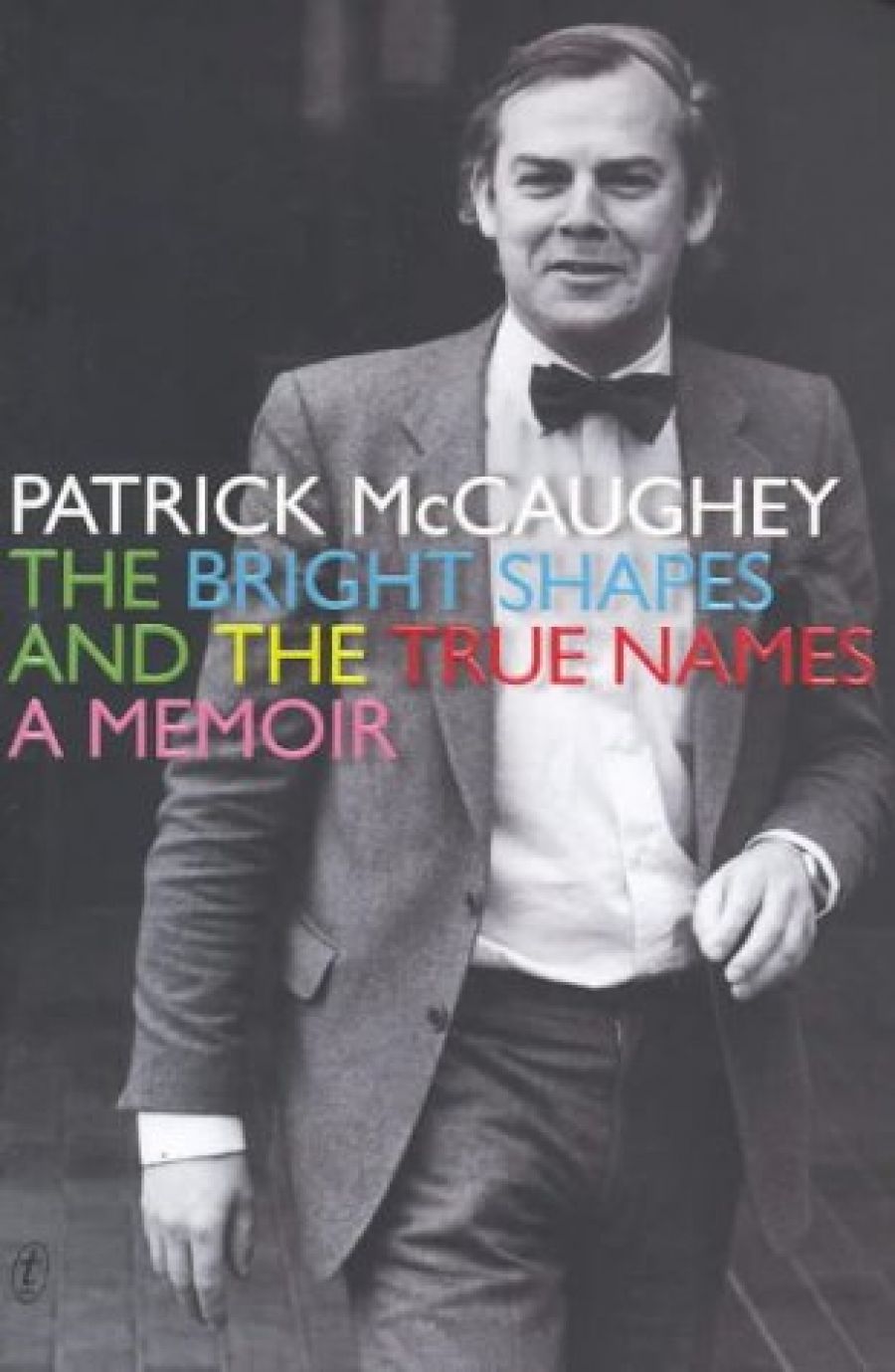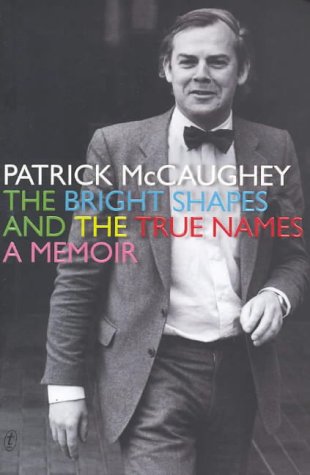
- Free Article: No
- Contents Category: Biography
- Review Article: Yes
- Article Title: No Free Ride
- Online Only: No
- Custom Highlight Text:
Being known as a personality can’t be all good. For all the fun that goes with quickness and dazzle, it surely becomes a little dangerous when you come to write an autobiography, or a memoir – whatever the distinction between these two terms is. This occurred to me when, passing the buoyant, bow-tied strider depicted on the front cover, I began to read Patrick McCaughey’s new book, subtitled A Memoir. After all, I have known the author for forty years here and there, in this role or that. Indeed, I remember him as a sixth-former, up at university to hear a literature lecture for schools, given by one of the English Department staff. Yellow scarf tossed back over the shoulder, he challenged her vigorously at question time. That’s one to watch, we thought.
- Book 1 Title: The Bright Shapes and the True Names
- Book 1 Subtitle: A Memoir
- Book 1 Biblio: Text, $32 pb, 285 pp
- Book 1 Cover Small (400 x 600):

- Book 1 Cover (800 x 1200):

Knowing him over the years, as he wrote poems, played cricket, directed plays, backed colour field abstraction, showed us round galleries, and dined with me in American cities, I keep reading this book against firsthand knowledge, finding it pretty accurate in this respect. McCaughey is proud of what he has achieved, and can say so in print, but he’s also aware of his excesses and lacunae. As Goethe wrote, ‘We look back on our life as a thing of broken pieces, because our mistakes and failures are always the first to strike us, and outweigh in our imagination what we have accomplished and attained.’
Among these ‘mistakes and failures’, McCaughey is alert to how far he neglected women artists and their products. Yet I suspect that even now they do not loom large in his consciousness. Politely, he names those he should have named, among them Janet Dawson, Lesley Dumbrell, and Jenny Watson, but they still occupy few lines in his narrative. We lay down the contours of our visual interests early on. The women who walk through this book are administrative colleagues, wives and lovers, and they walk with grace: they are seen with a man’s equable eye. Aboriginal art also came to him late, as to many of us.
The Bright Shapes and the True Names is an autobiography-to-date by a man of many parts, a natural extrovert who has directed three major art galleries, as well as having been a youthful Monash professor. As the title, drawn from his admired teacher Vincent Buckley, indicates, he has sustained much interest in poetry and drama as well. On both sides of the Pacific, his life so far has been a colourful one, his stutter imitated in a thousand conversations. But he has always had to be on his guard against becoming merely what Yeats called ‘a smiling public man’.
This book is well worth waiting for. We read with sustained interest from young Patrick’s tenth birthday, an Irish boy in alien Colombo, through thickets of family and friends, to his acceptance of top job in the Wadsworth Atheneum, that ‘pocket battleship of a museum’. The reader’s pleasure is only mildly abated by accounts of high-powered committee and board meetings, some of which sound like lightly civilised Hell. At best, though, he is as funny as Clive James, his wonderful oral quickness crystallising in print as paced fluency. ‘We knew that we were in for a night of trivialities,’ he writes; or, more generously, ‘The charming, literate man was the same man who saw the fires flickering, at the edge of vision.’ His book on Fred Williams finally emerges: ‘Joe Burke launched it guardedly in a poky room at the Australia Hotel.’
Wary of his early reputation as a fierce reviewer, McCaughey is very generous to friends and curators. And of course to painters, though he doesn’t give us a great deal about the art itself. The book is above all a warm tribute to some close friends: Fred Williams, Philip Martin, Peter Corrigan, Vin Buckley, and Sir Andrew Grimwade among them. Barbs are reserved for a few politicians, Susan Ryan in particular and, by the crafty paths of judicious quotation, Race Mathews.
He is very funny in a get-the-Pom way about Anthony Blunt: ‘I knew him to be English by his nylon socks and the gap between the bottom of his summer slacks and his sandals.’ But for the most part he sounds the diplomat, the judicious, engaging man he has had to be at the National Gallery of Victoria, the Wadsworth Atheneum, and the Yale Centre for British Art. At the last, he reigned awhile over God’s plenty, leaning over my shoulder once to announce how many more Stubbs and Wrights of Derby they had in the storerooms.
It is a book of anecdotes, rather than of the one-liners he can rap out in conversation. He is good about his easygoing schooldays (‘A prefect at Scotch entered a world of untrammeled ease and power’) and about his Bridesheadish undergraduate years; as a student, he famously wrote the lyric ‘Untimely Ripped’, was also ribbed by his peers for publishing a lousy poem by his old schoolfellow Anthony Staley, did a production of Othello, and had very mixed academic results.
Emerging, McCaughey trod the rounds as a newspaper art reviewer, and became a spokesman for the new generation of Field painters, as they came to be called. Nevertheless, his social alliances veered towards the Rudy Komon gang, older, figurative artists who included Williams, Leonard French, and Jan Senbergs; these were solid company as far as good talk and good wines were concerned. And it must have been through them that he met that lumbering, lovable and undervalued abstractionist, Roger Kemp. These were obviously pleasurable years, and yet he confesses that: ‘When I reread my reviews from the early 1970s, their rancorous illiberality appalled me. However truthful my reactions may have been, I mocked the weak and the defenceless.’
Some of his anecdotes become full-dress stories, above all the one that really hit the headlines: the occasion in 1986 when the Australian Cultural Terrorists stole Picasso’s Weeping Woman from the NGV. (Some of our readers surely know who they were. Come on.) It is a rattling good yarn, illustrated by three comically histrionic photographs. The painting came back safely in the end. We shall see it again when the revamped ‘Kremlin of St Kilda Road’ opens to its public in December.
Like the bobbin on a worldwide loom, the book shuttles between Australia and the US. In New York with his young family, he meets the powerful Clement Greenberg, along with a swag of Aussie expats, the first generation to choose the eastern US rather than Europe for their wandering years. The continent of Brobdignag comes to loom very large in his life, first evoked by Robert Lowell’s poetry.
History was taking its course. Indeed, not being so introspective a work as Bernard Smith’s The Boy Adeodatus, McCaughey’s story is of particular value as a history of Melbourne’s visual culture. Readers under fifty are here invited into a newly confident, masculine world of Australian art that came to being in their parents’ time, a little world that was to precede what the author calls the ‘semi-stagnant’ period of the early 1970s.
This is a good book about hospitality, as well: the Hattams’ crowded household in South Yarra is vividly evoked, for instance, as is the relaxing role of Fred Williams’s five-thirty drinkies. It also gives an insider’s view of how committees and art museums are run, when the crunch comes. Yet McCaughey ends his memoir early, on the brink of his Wadsworth directorship, tossing in the brisk one-liner about Australia: ‘Nobody is given a free ride.’ For better and for worse, he seems to say.


Comments powered by CComment